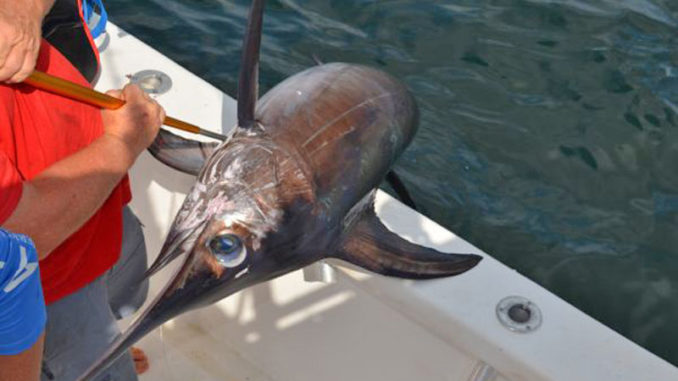
The Gulf of Mexico doesn’t look big on a map, but it’s a big ocean when you are looking for open-water fish like swordfish.
Capt. Peace Marvel does most of his fishing in the south end of the Mississippi Canyon, the deepwater indentation into the Continental Shelf west of the current mouth of the Mississippi River.
He hunts in waters 1,200 to 1,600 feet deep.
“Some spots are better than others,” Marvel said. “I have hundreds of dollars and thousands of hours invested in finding where the fish are. I start with bathymetric data from oil company work and government surveys.
“They are all off — even the high-dollar oil ones. All they do is give us an idea of where to look. What is on a chart or map is different than what is actually there; we have to go there to verify the existence of features and get exact locations.”
He spends every opportunity searching for likely swordfish haunts.
“Occasionally I do it with a charter customer on board, but I do it most often when I get a cancellation and the weather is good,” Marvel said. “I jump in the boat and go.
“I’m looking for ledges, holes, bumps — anything different. Bottom structure is what makes the difference. The more distinct the feature is, the better.”
Interestingly, bottom type doesn’t seem to make a difference.
“We have caught them on both mud and hard bottoms,” the captain explained.
Water temperature
Marvel also watches his water temperature gauge closely as he runs. He likes areas of upwelling, where cooler bottom waters are pushing up to the surface.
“A tenth of a degree difference cooler can indicate upwelling,” he said. “If I am in an area with good bottom structure and have upwelling, you can bank that we are going to mess up some swordfish.”
Marvel has six spots he calls “dependable,” and about 30 that he has studied on paper but not surveyed fully in detail on the water. Added to that, he has “hundreds” of spots that look interesting on paper.
“Also, whenever I am running from spot to spot, I keep my eye on the depth sounder,” Marvel said. “When I see anything different, I say, ‘Whoa’ and circle back.”
Whatever he is doing, it works. At the time of this writing his customers hold five of the top 10 swordfish spots in the Louisiana Fish Records Program.
